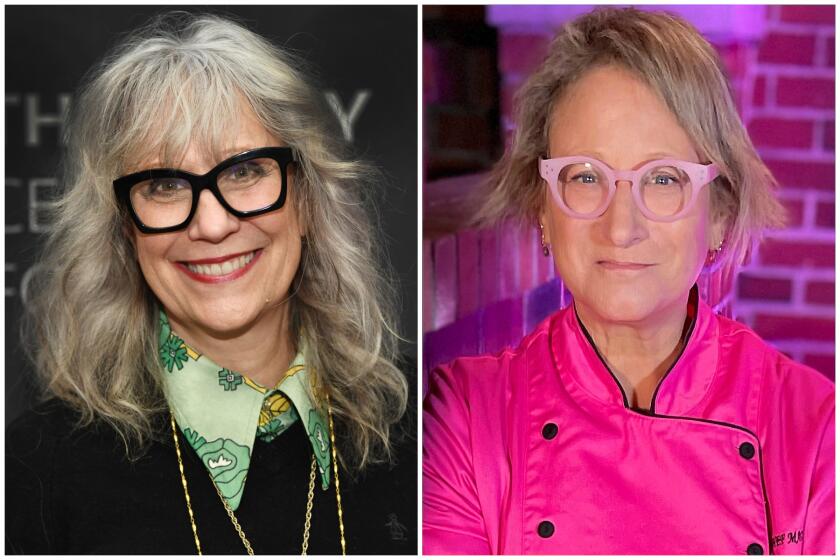Molly Shannon is a comedy legend. Now she’s opening up about the tragedy that shaped her
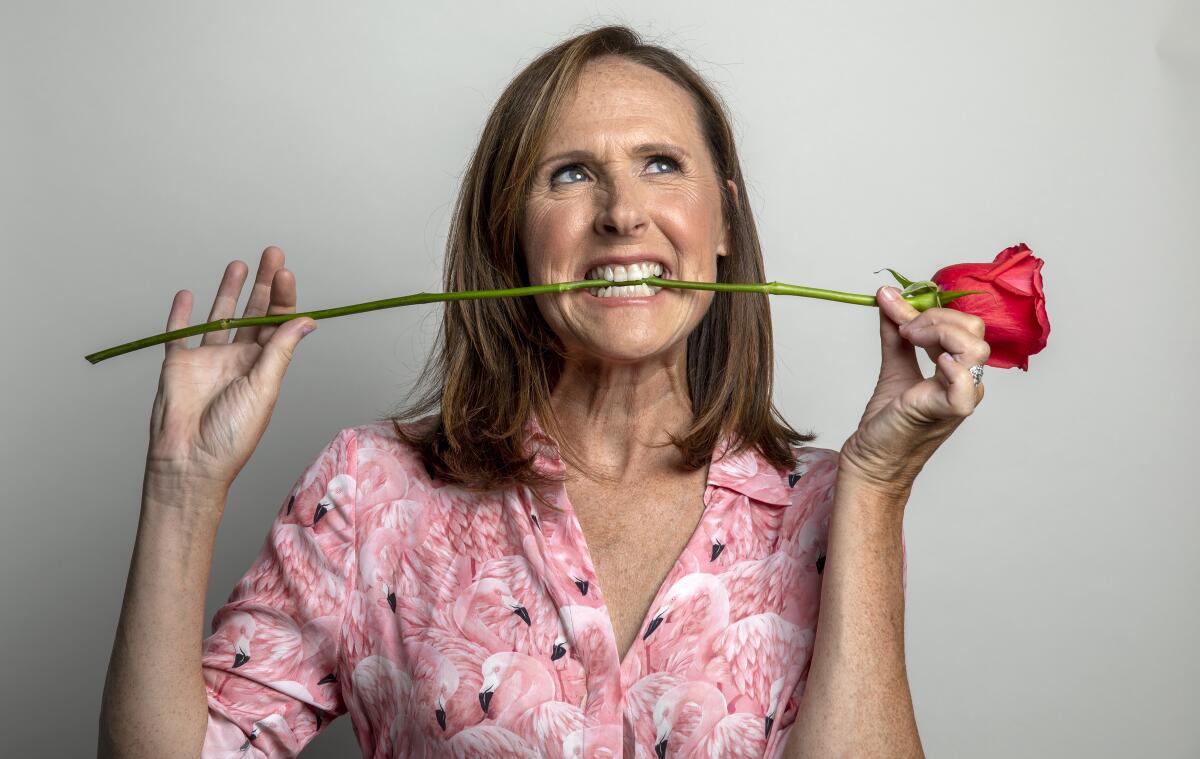
- Share via
When Molly Shannon played Mary Katherine Gallagher on “Saturday Night Live” in the late ’90s, she hurt herself. A lot.
So complete was her dedication to the armpit-sniffing, monologuing Catholic schoolgirl that she’d willingly throw herself into a pile of metal chairs, without padding, and barely register any pain. Then she’d wake up the next day and wonder where the cuts and bruises on her body had come from.
“Isn’t that weird?” says Shannon, 56, sounding genuinely mystified, in a recent video chat from her backyard in Los Angeles. “I didn’t care if I cut myself or I made myself bleed. I did not give a s—. I looked at it like punk rock. I was reckless, and because of what I went through, I just didn’t care about anything. ”
The complete guide to home viewing
Get Screen Gab for everything about the TV shows and streaming movies everyone’s talking about.
You may occasionally receive promotional content from the Los Angeles Times.
Shannon is obliquely referring to the deaths of her mother, younger sister and cousin in a car accident when she was 4. Her father, who had been driving under the influence, survived but was horribly injured. In her years of fame, she hasn’t talked much publicly about the accident or its aftermath — it’s not easy fodder for a late-night TV appearance, she says — but it cast a long shadow over her childhood in Shaker Heights, Ohio.
“I was very heartbroken and very sad and just trying to hold it all together as a kid,” says Shannon, who has two teenage children with her husband, artist Fritz Chesnut. “There’s no way that you could feel that type of deep pain about your mother and your sister being dead, so you just hold it all in, and it comes up later in life.”
This profound loss shaped the career of a woman who kept viewers in stitches for seven seasons on “SNL” and has since ascended to National Treasure status. Dating back to the endearingly volatile Gallagher, Shannon has gravitated to characters whose wholesomeness is often suffused with something darker and more complicated — instantly familiar everywomen with deep reserves of sadness and anxiety.
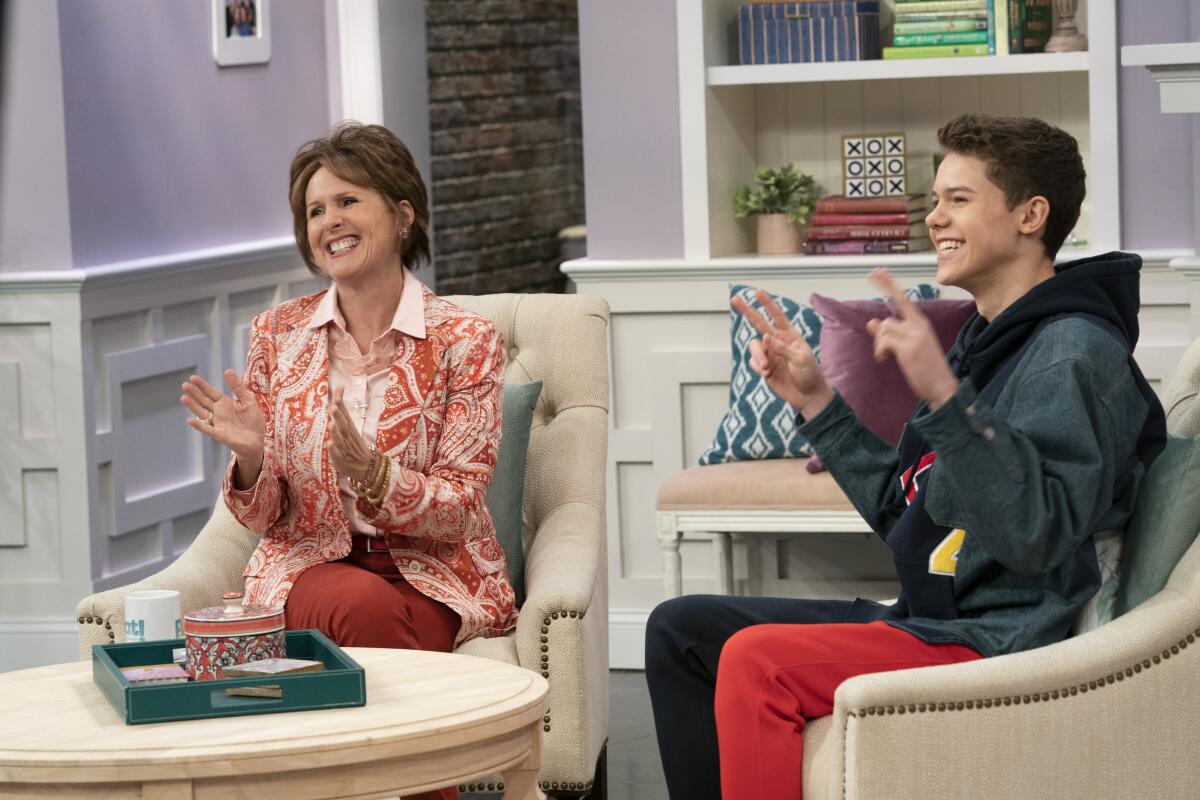
She’s pursued risky, genre-bending projects that explore difficult themes through a humorous lens, including the caustic HBO comedy “Divorce” and the quirky Emily Dickinson biopic “Wild Nights With Emily.” And while she’s no longer crash-landing on dinner tables in the name of art — “I’m a mother and I want to be physically able to walk,” she says — her commitment to her characters remains unwavering.
This month, she appears in two scene-stealing TV roles tailored to her brand of cheerful chaos. In HBO’s buzzy summer satire, “The White Lotus,” written and directed by her friend and frequent collaborator Mike White, Shannon appears as a society matriarch who intervenes in her son’s disastrous honeymoon.
And she returns as Pat Dubek, a grieving widow-turned-daytime talk show host, in the long-delayed second season of HBO Max’s “The Other Two,” created by former “SNL” head writers Chris Kelly and Sarah Schneider.
Beyond that, she has a lead role in the Showtime comedy “I Love This for You,” expected next year, and a memoir, “Hello, Molly!,” which will come out in April. The book will delve into Shannon’s family life and her lovingly complicated relationship with her late father, who came out late in life.
Lizz Winstead and Madeleine Smithberg created the beloved news satire, which premiered 25 years ago. Why haven’t they gotten credit for it?
Shannon feels vulnerable sharing many of these experiences publicly for the first time. “You feel like you put your heart right there on the table,” she says, “but I hope that my story can help other people.”
“I think when you’ve been through what she went through, you recover from it, but it changes you,” says a friend, “SNL” producer Lorne Michaels, whose father died when he was 14. “And you’re much more apt to appreciate moments when things are good than other people, who sort of race through them. It forms you, and I think [it’s part of] the seriousness that she brings to what she does. It’s always underneath.”
After the accident, Shannon and her sister, Mary, went to live with their aunt while their father recuperated in the hospital.
“The life that we left was not the same life we were coming back into. It just felt like everything was different. And I wanted my aunt to do stuff like my mom. I was like, ‘No, my mom cuts the crust like that’” — Shannon angrily gestures chopping with her hand — “Everything made me mad.”
Even joyful experiences were clouded with sadness, she says. At school, she felt like a war survivor. “We would learn to do fun stuff, like tie our shoes, and I felt like, ‘Katie, my little sister, should be here learning. She would have loved this. Katie would have loved doing the rabbits and tying her shoe.’”
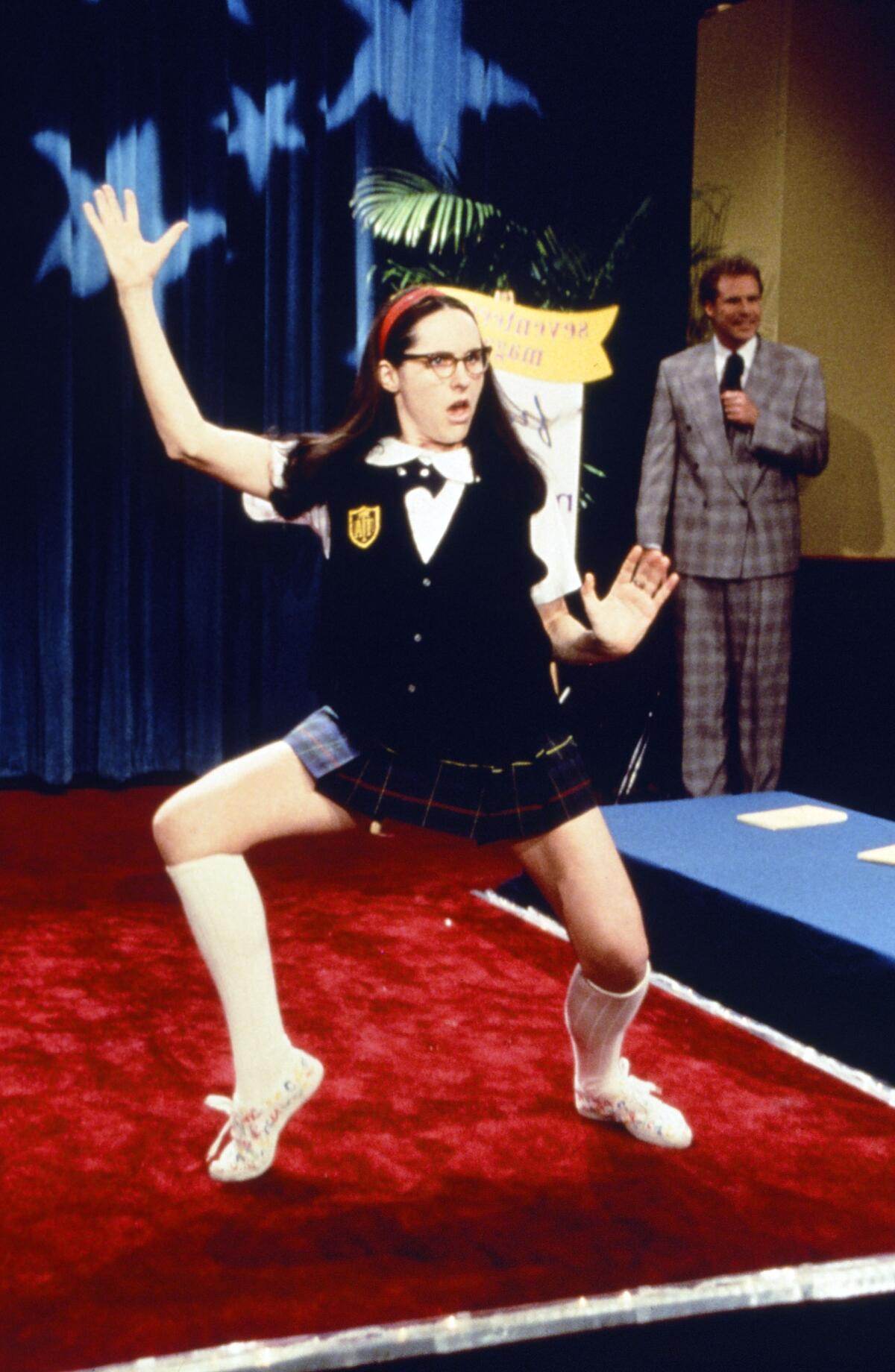
Decades later, Shannon went to see “Ponette,” a French film about a 4-year-old girl whose mother dies in a car accident. “I just sobbed and sobbed. I’d never seen a movie that captured how I felt as a kid,” she says.
Shannon found an escape in performance. In fifth grade, she became involved in professional children’s theater, playing Dorothy in “The Wizard of Oz. She loved being around drama nerds, because “They were different than Catholic kids — more affectionate,” she says. “That was what first attracted me. How sweet they were. They would hug you, and I missed some of that from not having a mom.”
She proved early on that she knew how to commit to a bit. When she was 12, Shannon and her best friend hatched a plan to go to the airport and sneak onto a plane — any plane. Her father encouraged the prank, because “he looked at this like an adventure — like, ‘See if you can get away with it,’” Shannon says.
They went to the airport dressed in leotards — Plan B was taking a ballet class — and wound up on a flight to New York City. This was in the ’70s, when you could walk straight up to the gate, she says. “It was just truly the greatest day of my life.”
Later, when Shannon enrolled at New York University, she found she loved the freedom of being immersed in out-there characters. She created Mary Katherine Gallagher during an improv exercise for a comedy show directed by her friend Madeleine Olnek (who later directed her in “Wild Nights With Emily”).
The actor, once known for romantic comedies, has taken on darker roles of late — including as a potentially dangerous version of himself in HBO’s “The Undoing.”
Gallagher “was really based on me, how I felt after the accident — really nervous, accident-prone, wanting to please, f— up but full of hope,” she says. “I just exaggerated everything I felt as a little girl and turned it into a character.”
People on campus started telling her that she should be on “Saturday Night Live.” And though it took her the better part of a decade — waiting tables, doing bit parts on sitcoms and performing her own material at comedy clubs in L.A. — she eventually got the call.
“Everything she did was fully formed,” Michaels recalls of her “stunning” audition. “You had this level of intensity where she’s totally in it. I don’t know how that level of determination was formed, but she had it the moment I met her. She was fearless. And also funny.”
Over seven seasons at “SNL,” Shannon became known for playing eccentrics with flailing limbs, oodles of nervous energy and mantra-like catchphrases, like high-kicking 50-year-old Sally O’Malley and Miss Colleen, the canine-loving host of “Dog Show.” Unlike many of her co-stars, Shannon never broke on air, even when Alec Baldwin boasted about his delicious “schweddy balls.”
“Her characters were so funny and manic and over the top, yet it still felt like they had a grounded human pathos and drama to them,” says Kelly, who cites the series’ Shannon-Ana Gasteyer era as a formative influence.
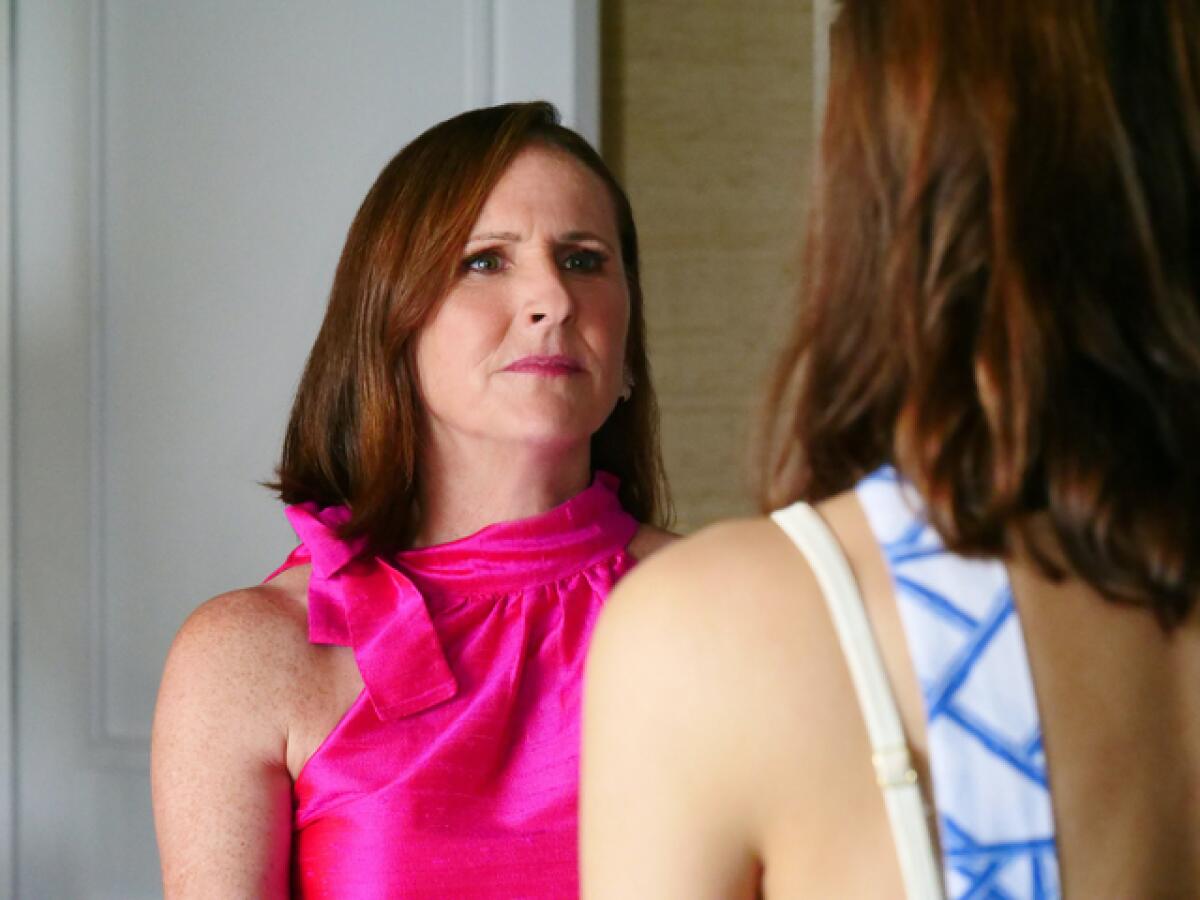
During production on Kelly’s semi-autobiographical film “Other People,” in which he cast her as a terminally ill woman whose comedy-writer son moves back to Sacramento to care for her, he marveled at Shannon’s ability to tap into wellsprings of emotion on cue. “In between takes, Molly would be like ‘Chris, did you ever go to summer camp?’” he says, affecting Shannon’s upbeat tone, “And ‘Action!’ And then she’d be sobbing. She’d go in and out of it so quickly — so authentically. It was wild.”
Shannon has “always gone for good work,” says Michaels. “I don’t think she’s been driven by money, particularly. It’s not about plotting a career trajectory. There’s something much more — I hate to use a word like integrity — but it’s just clear: Her choices are cool. And she attracts people who are doing those things.
“She’s one of my favorites, obviously,” he adds.
A major post-“SNL” turning point came when White cast Shannon as a pill-popping mom in the irreverent sitcom “Cracking Up,” which Fox canceled in 2004 after six episodes. White decided to make it up to Shannon by writing “Year of the Dog,” a darkly funny indie film about a single woman whose life unravels after the accidental death of her beloved beagle.
“Mike gave me such a chance by believing that I could do drama,” says Shannon, who credits White, Kelly and Schneider with generating material that plays to her dexterity as a performer. “They know me, and those sides of me that are more serious, so they know how to write for me.”
Ahead of Sunday’s finale, catch up on our coverage of the series, from its $9,000-a-night ‘hotel from hell’ to its most glaring blind spots.
Like seemingly everyone in Shannon’s orbit, White praises not only her talent but also her irrepressibly positive attitude on set. “She’s like a hype woman, just making it feel like ‘This is the best production anyone’s ever been a part of,’” he says. “Honestly, sometimes I’m like, ‘What would Molly Shannon do? How would she deal with this annoying situation?’ She just always remembers why we are genuinely lucky to work in this business, which I sometimes forget.”
Case in point: She gushes that filming “The White Lotus” in Hawaii was a “dream job for a mom,” because she got to bring along her children, Stella and Nolan. They did remote school from the hotel and would wave at her between takes as they went off to snorkel.
She also insisted on seeing the good in her character, a woman from old money who tells her daughter-in-law there’s nothing wrong with being a trophy wife. “She really cares about her son’s happiness, so she’s got to set this girl straight,” Shannon says. “I always tried to understand the character’s values and what’s important to them.”
Shannon takes the same approach to Pat in “The Other Two,” an absurdist comedy about contemporary fame. When Pat’s teenage son becomes a Justin Bieber-esque YouTube star, the unassuming Midwestern mom decides to embrace the celebrity lifestyle. The juxtaposition between the lovably basic Pat and her slick new world is a source for much comedy. (She hangs a Thomas Kinkade calendar in the industrial loft she’s subletting from Justin Theroux.)
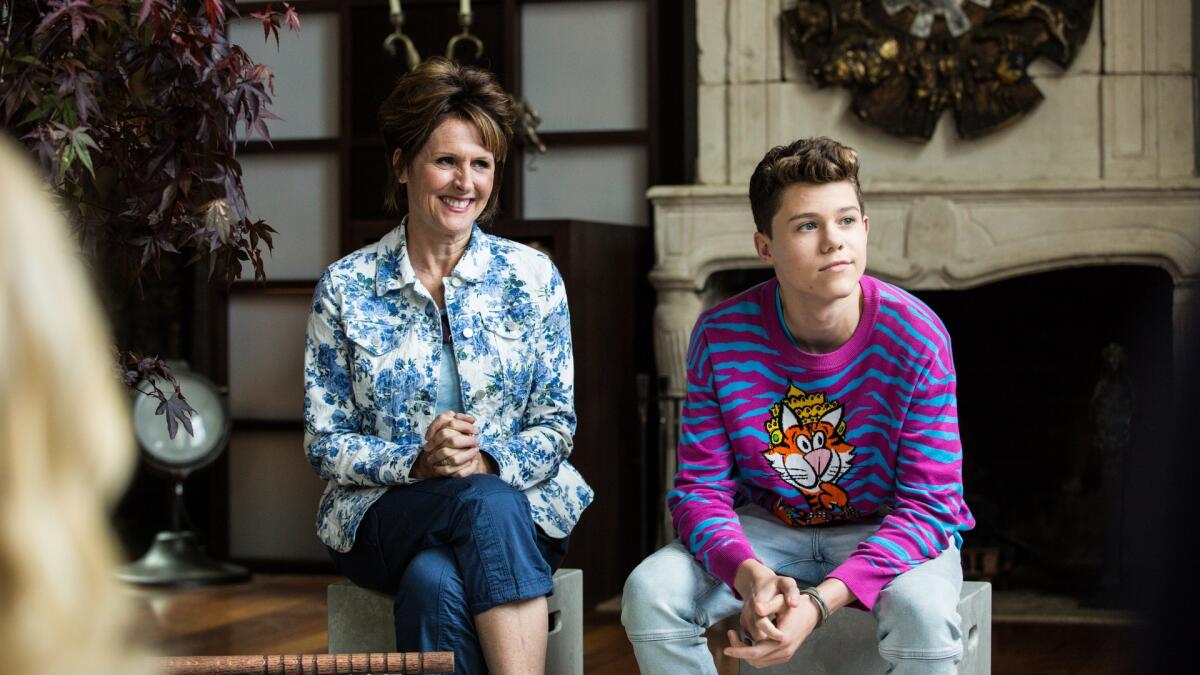
But there is real pain hidden underneath Pat’s Kate Gosselin bob. In a climactic moment late in Season 1, she reveals that her husband, an alcoholic, did not die of cancer, as everyone believes, but rather perished in a cartoonishly grim accident she kept secret to protect her young son. Shannon plays the scene completely straight, wringing genuine anguish from a ludicrous scenario.
During scenes like this, “I’m not thinking about trying to be funny at all,” says Shannon. “I don’t like when comedy people make fun of their characters, or they’re slightly distant. I really immerse myself in the truth, because it will be funnier.”
In Season 2, Pat is now the host of a popular daytime talk show. Despite constant encounters with fawning fans and a grueling schedule, she has yet to become jaded. Shannon says she relates strongly to Pat, a devoted mom brimming with excitement about the latest chapter in her life.
“Molly is not taking any single day or opportunity for granted,” says Schneider. “There’s such a humanity within her because of everything that she’s experienced.”
You can hear Shannon’s positivity in the words with which she peppers her sentences. Anchoring coverage of Prince Harry and Meghan Markle‘s 2018 wedding live from the U.K. in character as syrupy anchor Tish Cattigan was a dream, she says. Filming a movie on location in Italy this year was fantastic. And, more than anything, Shannon feels lucky to have a family and a thriving career as a performer.
“I look at life differently, losing my mom, and living beyond years that she ever got to live,” she says. “And I feel gratitude.”
More to Read
The complete guide to home viewing
Get Screen Gab for everything about the TV shows and streaming movies everyone’s talking about.
You may occasionally receive promotional content from the Los Angeles Times.
